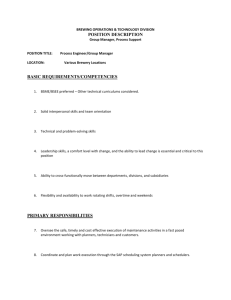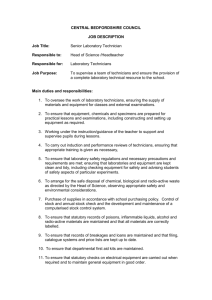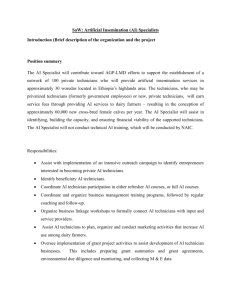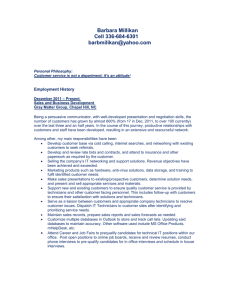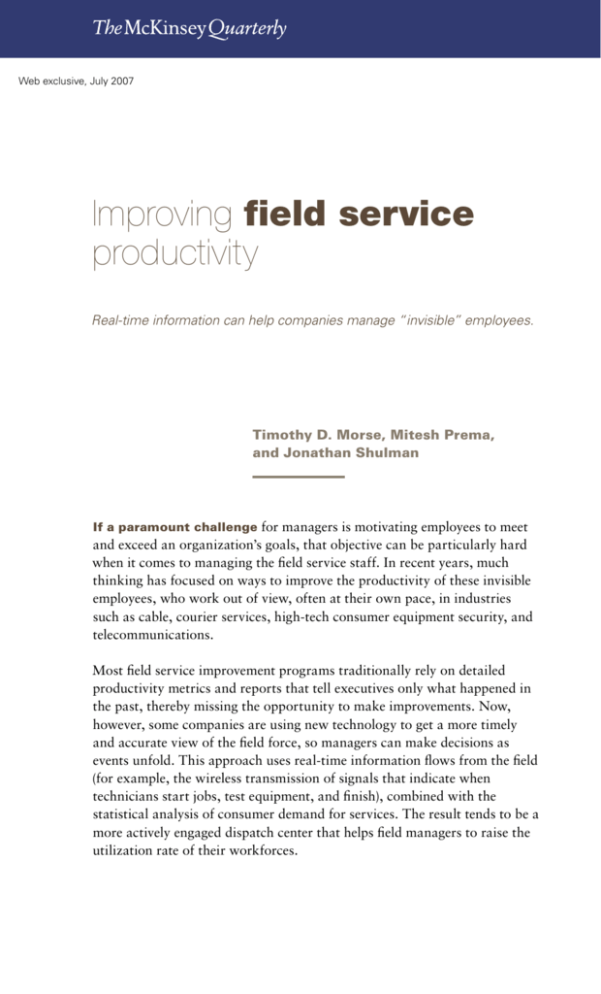
Improving field service productivity
Web exclusive, July 2007
Improving field service
productivity
Real-time information can help companies manage “invisible” employees.
Timothy D. Morse, Mitesh Prema,
and Jonathan Shulman
If a paramount challenge for managers is motivating employees to meet
and exceed an organization’s goals, that objective can be particularly hard
when it comes to managing the field service staff. In recent years, much
thinking has focused on ways to improve the productivity of these invisible
employees, who work out of view, often at their own pace, in industries
such as cable, courier services, high-tech consumer equipment security, and
telecommunications.
Most field service improvement programs traditionally rely on detailed
productivity metrics and reports that tell executives only what happened in
the past, thereby missing the opportunity to make improvements. Now,
however, some companies are using new technology to get a more timely
and accurate view of the field force, so managers can make decisions as
events unfold. This approach uses real-time information flows from the field
(for example, the wireless transmission of signals that indicate when
technicians start jobs, test equipment, and finish), combined with the
statistical analysis of consumer demand for services. The result tends to be a
more actively engaged dispatch center that helps field managers to raise the
utilization rate of their workforces.
The McKinsey Quarterly Web exclusive, July 2007
Article at a glance
Field service operations usually don’t respond to
conventional productivity-improvement programs,
because managers have difficulty coordinating the
work of employees they can’t see on the job.
A new approach relies on real-time data from the
field to inform a dynamic dispatch center that helps
managers raise utilization rates by identifying capacity
in the workforce and reassigning field technicians.
A flexible approach to scheduling work and an
ambitious and realistic plan for booking it help to fill
in available capacity. Combined with a sophisticated
approach to forecasting demand, these changes can
dramatically improve productivity by raising the
number of assignments that field technicians can
undertake in a typical day, reducing wait times, and
improving customer service.
Related articles
on mckinseyquarterly.com
Beyond a flexible approach to
scheduling and a more attentive
management style, these techniques
can substantially improve labor
productivity and customer service.
One US cable company that began
using a real-time dispatch system
increased the number of jobs
completed each day by 80 percent,
which in turn reduced, by
30 percent, the time customers spent
waiting for appointments with
technicians. In another case, a
security company that adopted these
techniques increased the number of
daily alarm installations by
35 percent while doubling its record
for timely arrival.
“Improving productivity in product services”
New communications and software
technologies underpin this approach,
“Finding the right level of call center staffing”
but changes in management style are
equally important. Managers will
need to supervise their field teams
more actively—for instance, by putting in more face time and occasionally
riding along to observe employees in the field.
“Measuring performance in services”
Field technicians too will have to adapt, learning to be more flexible in their
daily schedules and accepting limits on the autonomy they value. In a recent
survey of field technicians at one security company, 92 percent said that
independence was their favorite aspect of the job. A challenge for managers
will be to focus the field staff on the performance and customer service
dimensions. In our experience, field technicians do want to improve
customer service; in fact, the same survey found that 91 percent of them
supported that very goal.
Identifying lost productivity
To understand the challenges field service managers face, consider the
experience of their technicians at the cable company mentioned earlier.
Before the improvements, a typical technician completed four to five jobs
(mostly installations and repairs) each day. But the productivity reports that
managers received offered them few insights—no information on wasteful
driving times, cancellations, or other reasons for lost productivity.
Improving field service productivity
A subsequent study conducted by riding along with the field technicians and
observing their typical daily routines revealed ample opportunity for
improvement: routing jobs more efficiently and reducing unproductive time
(technicians arriving at their first job late, taking long coffee breaks, eating
Web 2007
leisurely lunches, and finishing early). Interestingly, the tasks themselves
Field services
Exhibitwere
1 of 2 completed fairly efficiently; opportunities for improvement were found
in
the closer
time attention
betweentothem
(Exhibit
1). technicians reveals pockets of wasted time.
Glance: Paying
the activities
of field
Exhibit title: Pick up the slack
exhibit 1
Picking up the slack
Disguised example of cable company
Pre-pilot
average
Targets
after pilot
Time wasted
over 8-hour day
70
30
40
Field agents typically reached first customer
site 70 minutes after starting shift.
4:30 PM
5:00 PM
30
Field agents ended work 30 minutes before end
of paid shift.
Average time to complete
a job, minutes
35
32
0
Little opportunity for improvement as technicians
were fairly efficient once they started work.
Average drive time per
job, minutes
24
15–20
30–50
Average lunch time,
minutes
99
60
40
Average time from shift
start to job start, minutes
Average finishing time
Total wasted time
Number of jobs
completed
Inefficient routing and driving patterns caused by large
work zones wasted 5 to 10 minutes per job.
Technicians took long lunch breaks, because they believed,
incorrectly, that lunch time = 1 hour plus drive time.
2 1/3 hours to 2 2/3 hours
6.3
8.5
Having identified the opportunities, senior managers needed a better
understanding of the field technicians’ daily routines. This extra visibility—
and a more flexible and dynamic dispatch system—were the cornerstones of
the cable company’s transformational program to improve productivity in
the field and address key quality issues, such as the punctuality of
technicians, waiting times for customers, and getting jobs right the first
time. Using improved routing software and making better use of mobile
phones, the teams in a pilot study established command centers that
provided real-time visibility into the schedules of the field workforce. They
also implemented innovative staffing and routing techniques designed to
meet customer demand more successfully. The command centers helped
field force managers to learn where technicians were, when they began and
finished assignments, and whether a test signal had been sent back through
the cable network to confirm that an installation was successful or a
problem had been fixed. In addition, managers learned (in real time rather
The McKinsey Quarterly Web exclusive, July 2007
than afterward) when employees were ignoring policies; as a result, the
company could immediately take corrective action, such as telephoning
customers.
The impact was dramatic: 18 months after the company launched the
program, technicians were completing an average of 8 jobs a day, compared
to 4.5 previously; the average waiting time for an appointment with a
technician had dropped to 1.2 days, from 5; and labor costs had decreased
by more than 30 percent, since less work had to be outsourced to external
contractors.
Creating and managing transparency
Any program to improve the productivity of a field force should address
three basic challenges. The first is getting a clear picture of what’s going on
in the field and setting up a dispatch center that can adapt to changes; the
second, rethinking the way jobs are booked: most companies plan their
operations in ways that leave too much capacity unused. The third involves
adopting more sophisticated forecasting models that take into account all
relevant factors and moving away from the tendency to forecast by memory.
Dynamic dispatch
Traditional approaches to scheduling a field force usually assign jobs only
for the day ahead and don’t respond quickly to changes—partly because
dispatchers aren’t aware of the field technicians’ activities or of pending jobs
in the pipeline. A more dynamic approach allows managers to see changes
as they unfold and to fill in gaps by adjusting schedules. In a typical day for
the field force of a cable or telecom company, for example, 5 to 10 percent
of all jobs are canceled, and 20 to 30 percent of them run longer or shorter
than expected—changes that create scheduling difficulties and, often,
unused capacity. Dispatch centers that track capacity in real time allow
managers to reschedule on the fly, matching people with jobs. While GPS
technology can help, it’s not necessary; mobile phones allow companies to
stay informed about the activities of field employees and to monitor data on
their locations and on the start and finish times of certain jobs (see sidebar,
“Tracking technologies”). A secondary benefit of real-time awareness is that
managers can track employees and rein in long breaks. Spot checks with
customers confirming the arrival and departure times of technicians
minimize the risk that employees will manipulate the system.
Improved capacity management
Most field service organizations allow some gaps in their schedules, for
urgent jobs that arise unexpectedly. Cancellations, however, consistently
outnumber them—a fact that many companies don’t know or overlook in
Improving field service productivity
planning. By taking this statistical tendency into account, managers can
Web 2007
safely overbook the days of technicians, since cancellations will probably
Field services
Exhibit 2allow
of 2 them to arrive at their assignments punctually and only occasionally
create
a need
for overtime
(Exhibit
2).
Glance: Field service
organizations
can benefit
from overbooking
appointments, much as airlines
overbook flights.
exhibit 2
Exhibit title: Booked up
Booked up
Disguised example of cable company booking for branch with 100 technicians,
points1 per technician per day
Daily target for loaded points (ie,
installation or service bookings)2
84
Some technicians assigned to tasks
other than calls
<1
Full load not booked, to allow for
some rescheduling
0
Too much time booked per job
0
Unfilled quota, caused by no rebalancing
among work zones
4–6
8
Points actually completed
56
Technician schedule measured more carefully,
reducing/eliminating time spent on other tasks
94
Rebalance schedule to limit amount of
unfilled quota
94
12–18
‘Must-do’ calls
Load more points than will be completed
Accurate estimate of time to complete
60–66
Cancelled calls
Overbooking model
Load appropriate levels of technicians
and points
6–8
0
Jobs booked for day
11
8–10
60–66
Actual quota
94
Traditional model
12–18 Balance cancellations and rescheduling
through dynamic dispatch
8
84–90
Points actually completed
point = 5 minutes of installation or service booking including driving time to and from job.
7 hours of productive work, allowing 1 hour for breaks and tech center time.
2Represents
A second capacity issue is the way geographic work zones sometimes create
rigidities that limit efficiency. A company that installs PCs and home
theater systems, for example, found that demand in specific geographic
zones tends to peak predictably—for example, during bonus week at a big
local employer or back-to-school days at a local university. At such times,
companies ought to shift technicians across zones to rebalance the
workload, boosting utilization rates by 15 to 30 percent.
Better demand forecasting
Field managers often blame flawed workload forecasts on the weather or
power outages, but analysis shows that these conditions have little impact.
The real problem is usually the lack of a good model for forecasting and an
The McKinsey Quarterly Web exclusive, July 2007
Tracking technologies
Technology can assist in driving field force
improvements, but not all are “must haves.” The
following list includes the types of solutions
available to management, in order of importance:
to complete each job, it can call the customer or the
field technician to see if a job has been completed,
reducing the potential for errors and the ability of
technicians to manipulate the data on assignments.
Real-time routing software. New applications
improve the way dispatchers monitor and schedule
the field force, by visually displaying both capacity
and exceptions (such as excessive driving times or
long breaks), thereby letting the dispatchers act
quickly to improve a given day’s performance. Some
systems also reduce driving times or assign jobs
to the nearest technician. UPS has a well-known
system that designs routes to minimize left turns,
thus saving fuel costs and the time of the
company’s drivers.
Wireless handhelds. Handheld computers, a boon for
transferring data between field agents and dispatch
centers, reduce the time employees must spend filling
out paperwork, allowing them to focus on the job. These
systems also allow field agents to access customer
account information, which facilitates maintenance and
up-selling efforts.
Call-ahead solutions. Autodial software, which can
check to make sure that customers are at home
while technicians travel toward them, dramatically
reduces the number of abortive visits—to
2 percent, from about 12. When the software is
linked to a database that records how long it takes
GPS. Global positioning systems can help improve
productivity by tracking the locations of technicians in
real time, particularly if they have daylong assignments
or if the time needed to complete the work is
unpredictable. In most cases, however, an effective
dynamic dispatch process, combined with input from the
field technicians, can reduce the need for GPS.
overreliance on gut instinct or memory. Many companies, for example,
don’t coordinate marketing and customer care with their field service teams,
which therefore don’t know about promotions that may affect demand for
installations or raise novel technical issues linked to newly introduced
devices or services. The introduction of digital video recorders, for instance,
can increase the demand for service calls by 40 percent in the initial phases.
A better approach to forecasting identifies broader cyclical patterns—not
only seasons and the weather but also the sales and marketing agenda, as
well as major events in the community (for example, the start of the school
year) or the media (say, a major sporting event). In the cable industry,
models built along these lines have been accurate up to 98 percent of the
time on a regional level, as compared with traditional field forecasts, which
are only about 75 percent accurate—too low to plan schedules effectively.
Better planning reduces the cost of overtime and contractors. What’s more,
a good support team ensures that trucks are appropriately stocked with
equipment and supplies in order to avoid repeat calls.
Making changes stick
Few of these changes endure without appropriate leadership and metrics.
Companies launch successful programs by enlisting the support of senior
Improving field service productivity
managers, ideally the CEO and the chief operating officer. Productivity
metrics must be visible to them, so they can cite successes to encourage
positive competition among regions.
Regional leaders, who must also rely on metrics, should encourage branch
managers to spend less time on reports and more time supervising their field
staff. Our experience shows that their active engagement—either by
speeding field technicians out of the door in the morning or by riding along
with them to observe and spread best practices—can have an immediate
impact on productivity. A close-up view of unproductive behavior in the
field (long breaks, short days) can help managers take immediate
corrective action.
If a workforce suffers from “change fatigue,” leaders may need to signal
their commitment to a major shift. One way is to launch a certification
process highlighting teams or regions that meet demanding standards (for
example, by achieving high percentages of on-time service) and continue to
meet them over time. Certification, which can be linked to compensation,
has proved a compelling way to ensure steady improvement.
Finally, companies can’t hope to reap all the advantages of a plan to
improve productivity unless they’re willing and able to change the size or
workload of the labor force. Such programs aim to raise each field
employee’s productivity; companies increase their profits by undertaking
more jobs with the same workforce or by serving the same customer base
with a smaller one. A typical field force has a fairly high turnover rate
(20 to 30 percent a year), so companies can often make adjustments through
attrition and reassignment.
Taken as a whole, these techniques aim to increase management’s
understanding of how effectively the field force works and thus to improve
productivity and customer service. Until recently, a lack of transparency
prevented field service managers from implementing the kinds of
productivity-improvement efforts that have successfully raised the standards
of on-site operations. Applying these methods in the field should help
managers pursue similar results there. Q
Tim Morse is a principal and Jonathan Shulman
is a consultant in McKinsey’s New Jersey office; Mitesh Prema is an associate principal in the
Miami office. Copyright © 2007 McKinsey & Company. All rights reserved.

